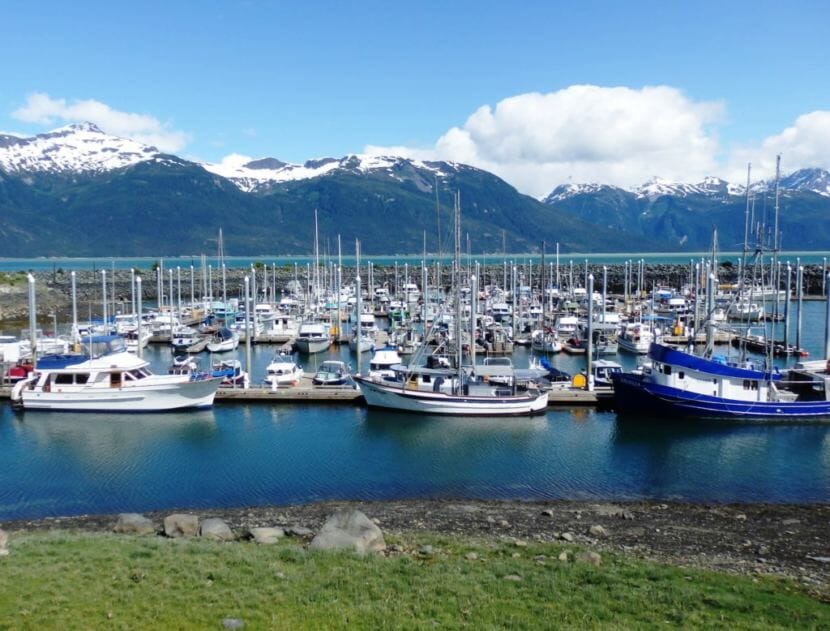
Sockeye salmon returned to Haines’ Chilkoot River in strong numbers this summer. The run is winding down, but tracking near the upper end of the escapement goal set by the Alaska Department of Fish and Game.
ADF&G Haines Area Management Biologist Wyatt Rhea-Fournier says a large portion of the sockeye run came in a big pulse of 38,000 fish.
“Kind of uncharacteristic if you look at the long term patterns for that lake,” Rhea-Fournier said. “Now, two of the last three years we’ve had these really large pulses of sockeye into the Chilkoot Lake.”
Now, as the run comes to an end, just over 84,000 fish have passed through Fish and Game’s weir on the Chilkoot River. That’s a good number, just below the upper bound of the escapement goal.
Rhea-Fournier says those numbers have allowed the department to open up fishing.
“We’ve given a lot of opportunity since that large pulse of fish came through,” Rhea-Fournier said. “Opening up the Lutak Inlet all the way up to the river mouth for extra days. The last couple days we’ve been open four days a week and five days a week. This next week it will be open for six days.”
On the Chilkat side, however, Fish and Game is still waiting. They still have a ways to go before meeting the escapement goal on the Chilkat River. But, Rhea-Fournier says that’s not unusual. He says the run tends to be more prolonged.
“If you look at over the last 10 years, by the end of August we have about half of our escapement through,” Rhea-Fournier said. “So that means we still have more fish to come. Right now we’re only at 44,000 fish. So we’re hoping that there is a whole second half of the run coming. Because, of course, our minimum goal on the Chilkat side is 70,000 fish.”
Rhea-Fournier says there are strong indications those fish are on their way.
“Our Chilkat River fish wheels picked up quite significantly,” Rhea-Fournier said. “We’ve had a lot of reports of subsistence fishers in the river, and in the salt water, catching a lot of sockeye. So we’re going to open for just two days and give a little more opportunity for the commercial fishers. So they’ll be able to fish up to Twin Coves here this next week.”
As the summer salmon season slows, Rhea-Fournier expects to see the start of the Klehini chum harvest.
“We do have a lot of our fishers who have moved on from their summer nets and are using what we call the fall gear,” Rhea-Fournier said. “That means they’re using a slightly larger mesh size and they begin to target fall chum salmon. Wild chum salmon that are returning up to the Klehini. They’re also starting to harvest coho salmon. Coho that are returning into the Chilkat.”
Meanwhile, the Chilkoot River is seeing a low return of pink salmon.
“Pink salmon coming into the Chilkoot River has been quite low,” Rhea-Fournier said. “We’re only at about 5,000 fish, which is pretty low, even for an even year. And in the fish wheels themselves, which monitor the Chilkat salmon migrations, they’ve been quite low over there as well. In fact, very low when you look at the 10-year average.”
Rhea-Fournier says the fish tend to follow a pattern, with weaker runs on even years.
“Upper Lynn Canal follows the same as the rest of Northern Southeast Alaska,” Rhea-Fournier said. “Northern Southeast Alaska pink salmon follow onto this odd and even year cycle where the even years, such as this year, have typically been much lower than the odd years.”
Rhea-Fournier says this isn’t a huge deal for the local gillnet fleet. But, it’s certainly affecting others in Southeast.
“We typically, as a gillnet fishery, don’t target a lot of pink salmon but definitely some of the other gear types, like the purse seiners, definitely were limited in opportunity because of the low abundance of pink salmon,” Rhea-Fournier said.
In the past week, 4,000 sockeye were harvested by commercial fishermen in District 15. They also caught 4,500 coho, 2,500 chum and 100 pinks.